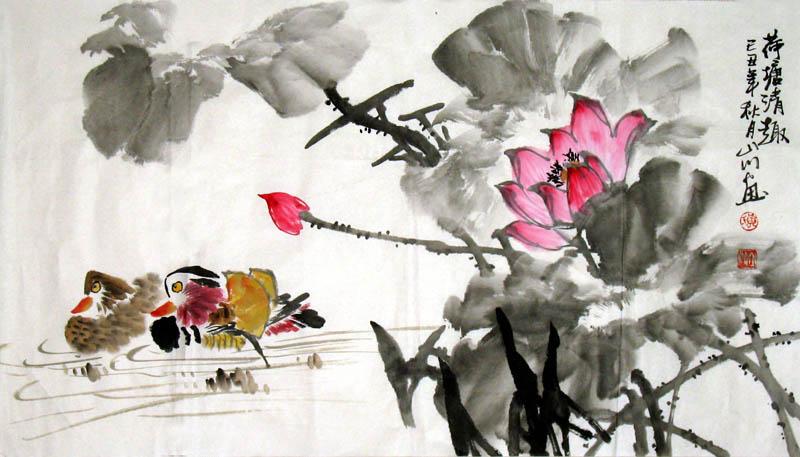Chinese Lotus Painting
Chinese Lotus Painting
The lotus is also known as a symbol of purity and perfection, growing out of the mud into a state of blossoming beauty and fruitfulness. The flowers are open for a mere three days, then petal by petal they disintegrate, leaving the green seed head exposed.
 It has become very positively connected to Buddhism, partly because of the symbolism; partly because of the visual representation of the Wheel of the Law by the flower form, with the petals taking the place of the spokes. Buddha is usually represented as seated on the sacred lotus and, in imitation of this, Buddhist priests have developed the 'lotus posture' – a cramped position which develops a state of bodily peace. The flower is also one of the eight treasures', said to be auspicious signs seen on the sole of Buddha's foot.
It has become very positively connected to Buddhism, partly because of the symbolism; partly because of the visual representation of the Wheel of the Law by the flower form, with the petals taking the place of the spokes. Buddha is usually represented as seated on the sacred lotus and, in imitation of this, Buddhist priests have developed the 'lotus posture' – a cramped position which develops a state of bodily peace. The flower is also one of the eight treasures', said to be auspicious signs seen on the sole of Buddha's foot.
It is not only a symbol important to Buddhists, that the lotus is recognized, but also as an emblem of one of the Eight Immortals of Taoism – the other main Chinese religion. The seed-cup on the lotus stem, holding as it does many seeds, becomes and emblem of offspring.
The lotus is also regarded as representing summer and fruitfulness; it appears in stylized form in paintings, in embroidery, on carpets and as ceramic decorations.
Although it is not an easy flower to paint, mainly because of the disproportionate size of the leaves and the fact that Western painter may well never have seen a lotus bloom, it is the most important flower in Chinese traditional painting and as such is well demonstrated by the power and versatility of shades of black.
2.Paint the pod heads first by outlining the seed pod and the tiny circular seeds.
3.Seed pods on their own should have a space left at the base so that the stalks can be joined correctly.
4.If the seed pods are still surrounded by the petals of the flower, then the petals grow from the base of the pod and over-lapping must be planned before the outlines are painted.
5.The flower petals are finely veined and, although it is not necessary to show them, light-toned, thin ink lines can be included.
6.The leaves can be shown in various stages and positions as they unfold.
7.On the large leaves, the veins radiate from the centre of each leaf and alternate veins 'fork' as they approach the leaf edge.
8.The leaf stalks are darker than the flower stalks.
Each flower, bud and leaf has its own individual stalk.
Each flower, bud and leaf has its own individual stalk.



